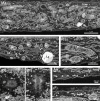Towards the imaging of Weibel-Palade body biogenesis by serial block face-scanning electron microscopy
- PMID: 25644989
- PMCID: PMC4670698
- DOI: 10.1111/jmi.12222
Towards the imaging of Weibel-Palade body biogenesis by serial block face-scanning electron microscopy
Abstract
Electron microscopy is used in biological research to study the ultrastructure at high resolution to obtain information on specific cellular processes. Serial block face-scanning electron microscopy is a relatively novel electron microscopy imaging technique that allows three-dimensional characterization of the ultrastructure in both tissues and cells by measuring volumes of thousands of cubic micrometres yet at nanometre-scale resolution. In the scanning electron microscope, repeatedly an image is acquired followed by the removal of a thin layer resin embedded biological material by either a microtome or a focused ion beam. In this way, each recorded image contains novel structural information which can be used for three-dimensional analysis. Here, we explore focused ion beam facilitated serial block face-scanning electron microscopy to study the endothelial cell-specific storage organelles, the Weibel-Palade bodies, during their biogenesis at the Golgi apparatus. Weibel-Palade bodies predominantly contain the coagulation protein Von Willebrand factor which is secreted by the cell upon vascular damage. Using focused ion beam facilitated serial block face-scanning electron microscopy we show that the technique has the sensitivity to clearly reveal subcellular details like mitochondrial cristae and small vesicles with a diameter of about 50 nm. Also, we reveal numerous associations between Weibel-Palade bodies and Golgi stacks which became conceivable in large-scale three-dimensional data. We demonstrate that serial block face-scanning electron microscopy is a promising tool that offers an alternative for electron tomography to study subcellular organelle interactions in the context of a complete cell.
Keywords: Endothelial cells; FIB; Golgi apparatus; SBF-SEM; Weibel-Palade body.
© 2015 The Authors Journal of Microscopy © 2015 Royal Microscopical Society.
Figures




Similar articles
-
Three-dimensional shape of the Golgi apparatus in different cell types: serial section scanning electron microscopy of the osmium-impregnated Golgi apparatus.Microscopy (Oxf). 2016 Apr;65(2):145-57. doi: 10.1093/jmicro/dfv360. Epub 2015 Nov 24. Microscopy (Oxf). 2016. PMID: 26609075
-
Developing 3D SEM in a broad biological context.J Microsc. 2015 Aug;259(2):80-96. doi: 10.1111/jmi.12211. Epub 2015 Jan 26. J Microsc. 2015. PMID: 25623622 Free PMC article.
-
Content delivery to newly forming Weibel-Palade bodies is facilitated by multiple connections with the Golgi apparatus.Blood. 2015 May 28;125(22):3509-16. doi: 10.1182/blood-2014-10-608596. Epub 2015 Feb 25. Blood. 2015. PMID: 25716207
-
New developments in electron microscopy for serial image acquisition of neuronal profiles.Microscopy (Oxf). 2015 Feb;64(1):27-36. doi: 10.1093/jmicro/dfu111. Epub 2015 Jan 5. Microscopy (Oxf). 2015. PMID: 25564566 Review.
-
Volume scanning electron microscopy for imaging biological ultrastructure.Biol Cell. 2016 Nov;108(11):307-323. doi: 10.1111/boc.201600024. Epub 2016 Aug 12. Biol Cell. 2016. PMID: 27432264 Review.
Cited by
-
Conductive resins improve charging and resolution of acquired images in electron microscopic volume imaging.Sci Rep. 2016 Mar 29;6:23721. doi: 10.1038/srep23721. Sci Rep. 2016. PMID: 27020327 Free PMC article.
-
Comparison of 3D cellular imaging techniques based on scanned electron probes: Serial block face SEM vs. Axial bright-field STEM tomography.J Struct Biol. 2018 Jun;202(3):216-228. doi: 10.1016/j.jsb.2018.01.012. Epub 2018 Feb 1. J Struct Biol. 2018. PMID: 29408702 Free PMC article.
-
FIB-SEM tomography of human skin telocytes and their extracellular vesicles.J Cell Mol Med. 2015 Apr;19(4):714-22. doi: 10.1111/jcmm.12578. J Cell Mol Med. 2015. PMID: 25823591 Free PMC article.
References
-
- Hall DH, Hartwieg E. Nguyen KC. Modern electron microscopy methods for C. elegans. Methods Cell Biol. 2012;107:93–149. - PubMed
-
- Hendriks CL, Van Vliet L, Rieger B, van Kempen G. van Ginkel M. 1999. DIPimage: A Scientific Image Processing Toolbox for MATLAB. Quantitative Imaging Group, Faculty of Applied Sciences, Delft University of Technology, Delft, the Netherlands.
Publication types
MeSH terms
LinkOut - more resources
Full Text Sources
Other Literature Sources

